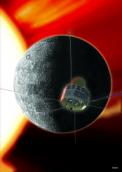Solar system plasma physics
The research concerns the plasma environments of solar system bodies other than Earth as well as the Sun and the Solar wind. Research interests include: solar wind interaction with magnetised and non-magnetised solid bodies, planetary magnetospheres, moon-magnetosphere interaction, and solar wind structure.

The first mission with KTH built electronics on-board destined for another solar system body was SMART-1 launched in September 2003, entering Lunar orbit at the end of 2004, and making a controlled crash landing on the Lunar surface in September 2006.
Our second solar system mission, Rosetta, has just finished its mission at the comet 67/P Churyumov-Gerasimenko.
Our major solar system mission is BepiColombo where we are responsible for an instrument to measure the electric field in the Mercury magnetosphere. BepiColombo is an ESA-JAXA mission comprising two modules, a planetary orbiter (MPO) and a magnetospheric orbiter (MMO). The mission will study the planet as well as the surrounding magnetosphere and will shed new light on a range of topics, including the formation of the solar system, the evolution of the Terrestrial planets, planetary magnetism, magnetospheric dynamics, and solar wind - magnetosphere interaction. In parallel, the solar wind will be monitored at a heliocentric longitude different from Earth's, clarifying the structure of the inner heliosphere.

The two orbiters are flying together to Mercury using solar electric propulsion as well as Venus and Mercury gravity assists for the cruise and chemical propulsion for orbit insertion at Mercury. Once they reach Mercury they will go into separate polar orbits, each optimised for the scientific measurements to be made. KTH participates in the Plasma Wave Investigation (PWI) which was selected by JAXA in November 2004. Together with colleagues in Sweden, Norway, and Finland, and in close collaboration with the PWI team in Japan, KTH provided an electric field instrument, MEFISTO, for the magnetospheric orbiter.
Together with our colleagues from the Swedish Institute of Space Physics we contribute to the ESA JUICE mission, which will study the icy moons in the Jupiter system. In preparation for the mission, we work on studies of Jupiters Galilean moons using Hubble Space Telescope and other remote sensing facilities. Our group is also looking to the new data from NASA's Juno mission at the giant planet.
Future potential missions we are involved in include targets such as the Moon, asteroids, and Europa (the second Galilean moon of Jupiter).
